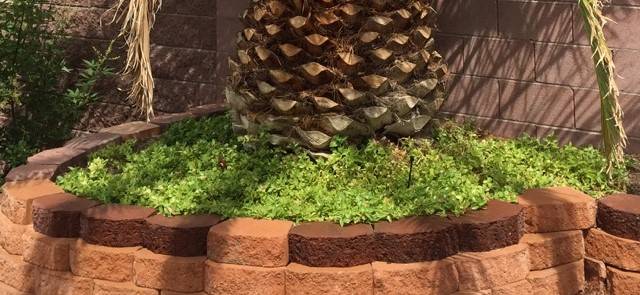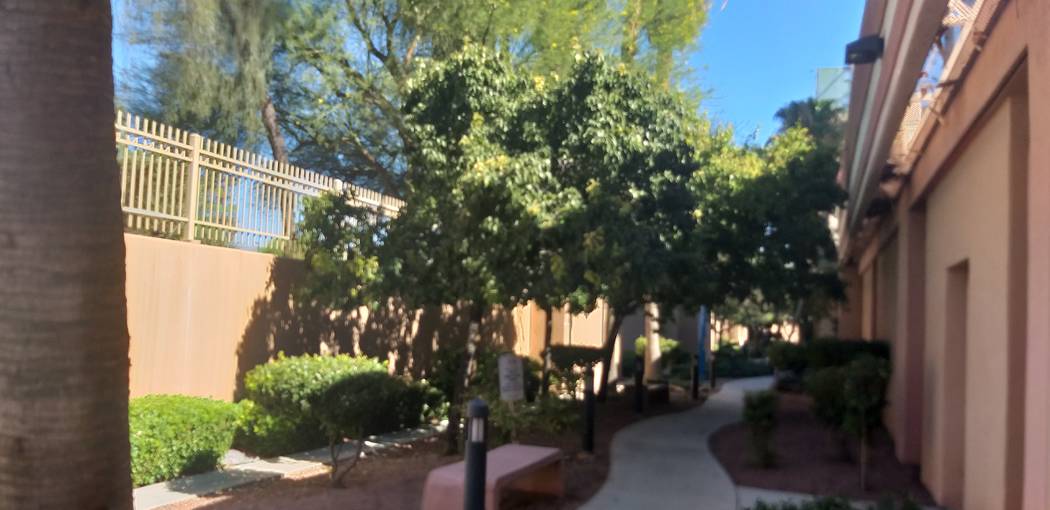Microclimates affect how plants grow, appear in the desert
Some people think I’m crazy when I mention the importance of microclimates in landscapes. Others may be unsure about what they are, how to establish these microclimates and if they’re worth the expense. It’s really whether you value the selection, appearance and quality of plants growing in your landscape.
Microclimates affect how plants grow and appear in the desert, their quality if you’re talking about vegetables growing in raised beds or fruit on fruit trees and how comfortable we are when enjoying a beverage or meal outside. Landscape microclimates change something about the outside: the air temperature, wind speed, humidity, noise level or may address privacy issues. All these change the microclimate in an otherwise open landscape.
A recent stroll through a commercial property on Maryland Parkway reminded me how important these changes can be for plants and for us. A section of this commercial property lowered the strolling and sitting area below this north-to-south-running street. This change provided morning and afternoon shade, influenced the direction of the wind and lowered wind speed and reduced the noise level from passing traffic 20 feet away.
Here, I found outside sitting areas enjoyed by employees on a hot morning. I found plants thriving, compared to their struggling counterparts 50 to 75 feet away. A simple lowering of the landscape elevation provided comfort for plants and humans alike without changes to the soil or irrigation different from the rest of the landscape.
Be creative. Changing the landscape elevation is one way to address problem areas. Other methods include trellising, building windscreens or diversions, use of gazebos, building partial walls, using manufactured screening, paint and other methods that provide a microclimate that improves the quality of plant growth and the outside living area. Remember that cement and steel are more durable surfaces than wood in the desert.
I will talk more about this subject on my podcast.
Q: Several pine trees on municipal park property provide privacy from people who frequent the adjoining park. All these pine trees have done well over the past 20 years except for one that is about half the size of the others.
It’s in a perfect spot to provide privacy for me but doesn’t because of its size. It gets plenty of sun and is not overcrowded by other trees, but I don’t see any water for any of them. How do I help the little pine tree get to the same size as his big brothers?
A: All those pine trees are irrigated or they wouldn’t survive in our desert climate and put on decent growth year after year. The smaller tree could have a problem all its own, separate from the others.
The fastest way to find out is to push hard on the tree trunk. You may have to push several times. After these many years, that tree should be solidly anchored into the ground. If it’s loose in the soil, the tree has a rooting problem and should be replaced. If a tree with this problem is not replaced, it will always be small and never grow regardless of what you do.
When you push on it, there should be no soil movement where the trunk enters the ground. If you do see movement beneath the trunk, the tree was root-bound when it was planted and never became established in the surrounding soil. That would be unfortunate, but this happens too frequently to landscape plants grown in containers.
Root-bound plants have roots that grow in circles inside the container. This root growth problem begins when plants are very young and is seldom a problem that develops when they are older.
It is possible plants can become root-bound if they are grown in a container that is too small for them for too many years. I suggest consumers don’t focus on the “largest trees they can find.” Smaller plants that are healthy and growing rapidly are always a better choice and will establish in the landscape faster.
Another possibility is a lack of water. Inspect the soil to make sure that irrigation is not the issue. If the plant is not root-bound, water the soil under the canopy of the tree with a hose, sprinkler and mechanical timer for one hour, once a week. Do this during the summer months. Fix the irrigation problem, of course, but the extra water once a week will help push new growth faster.
Fertilize pine trees once a year in the spring with a tree and shrub fertilizer such as 16-16-16 or 20-20-20.
Q: As much as I love them, geraniums are just too high maintenance for me this year so I gave up on them. Can you recommend something, in addition to lantana, that is colorful and low maintenance?
A: Similar to vegetables, flowering plants have a time of year when they perform best. Lantana is generally a summer-flowering woody perennial while geraniums, even though they are perennial, flower best during the cooler months of October through March. The usual planting dates may vary somewhat with the weather, but it should be around early to mid-October.
Some common alternatives for geraniums used as annuals during the winter months include snapdragons, pansies and petunias planted with alyssum and lobelia. Even though they aren’t true winter annuals, they grow best during the cooler weather of midfall through early spring.
Some fall flowering plants for fun that you can start from seed include bells of Ireland, calendula, candytuft, cornflower, gilia, larkspur, lupines, pinks, stocks, verbena and viola. Many of these will self-sow themselves year after year. I will put a more complete list on my blog.
Pay attention to their mature size. Taller plants go in the back of the planting area and smaller plants go in the front. Before planting any of these nondesert flowering annuals, mix a decent compost into the soil before planting if it’s going in a bed.
A 1-inch layer of compost mixed into the soil 6 to 8 inches deep annually at planting time, just like a vegetable garden, is enough. If the compost is a dark brown or black amendment rich in nutrients, don’t add any fertilizer at planting time and for the first two to three months after planting. If the compost is not rich, mix in a high phosphorus fertilizer with the compost just before planting.
Deadhead these plants regularly. Removing spent flowers produces more flowers and extends the life of the plant. Fertilize these winter annual flowers lightly with a high nitrogen fertilizer once a month.
Q: This spring we relandscaped our yard to include six groundcover plants called hearts and flowers groundcover planted in full sun. They did really well in the cool, rainy spring. As the weather got warmer, most of them turned brown starting at the center of the plant and extending outward. They are watered with two each two-gallon-per-hour emitters for 30 minutes three times a week.
A: It sounds like it just got too hot for them in that location. These plants are short-lived in the desert. Hearts and flowers are succulents and not as tough in full sun as many cactuses. They grow best in the cooler months of spring and fall. They originate in the warm and dry parts of South Africa in locations that have summer monsoons.
Hearts and flowers will grow in full sun out in the open if it is not a southern or western exposure with reflected heat. Plants will handle heat better if they are planted in soils amended with good compost but prefer light shade in the afternoons. The best place to put them is morning sun with some light shade in the afternoons or on the east-facing side of a wall. Typically, they have very few pest problems.
Bob Morris is a horticulture expert and professor emeritus of the University of Nevada, Las Vegas. Visit his blog at xtremehorticulture.blogspot.com. Send questions to Extremehort@aol.com.
























